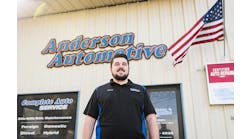Jimmy Sexton had no idea what was wrong.
After 22 years of successfully running an auto care shop, his average repair order (ARO) was all the way down to $250.
Sitting down with his business coach, they looked through Sexton’s shop statistics and numbers and noticed a glaring outlier.
“[My business coach] looked at a couple of papers, and then he looked at me and said, ‘Are you doing the courtesy inspection list every time?’” Sexton recalls. “I said, ‘Honestly…probably not.’”
His shop offered a free courtesy inspection, which is meant to help catch minor problems, such as broken headlights, and sell preventative maintenance. It’s a simple, efficient service that doesn’t take too much time—which is probably why Sexton never thought twice about it.
Sexton, owner of Jimmy’s Automotive in Asheville, N.C., now looks back and remembers all of the signs staring him right in the face. It was a simple process, but it was just as simple to botch the courtesy check, or forgo it altogether. What he needed to do was not only address his technician’s attitude toward the courtesy check, but offer an incentive as well.
The Backstory
Sexton started out in a flat garage by himself, slowly attracting customers, adding three more bays, and eventually moving to his current location after 13 years of growth.
Jimmy’s Automotive
Location: Asheville, N.c
Size: 10,000 square feet
Staff: 9 (5 technicians, 2 service writers, 1 front office worker and 1 owner)
Annual Revenue: $1.2 million
Now operating out of a 10,000-square-foot shop with 12 bays, his philosophy hasn’t changed one bit since the beginning: Do a complete job.
“I love people. I love cars. It's just what my purpose is,” Sexton says. “It's just comfortable for me. I want to be the best that there is. And I don't want to leave anything unturned.”
Nothing unturned—that was the key. When a customer came into his shop and he was able to offer additional maintenance, Sexton knew the customer was hooked. He had gone above and beyond, showing he wanted to take care of the customer.
That philosophy was the core of his success, the impetus for establishing the courtesy check. So when everything went wrong, he knew it was time to make a change.
The Problem
Through a combination of complaints and an abnormally low ARO, Sexton began to notice that courtesy checks weren’t being performed properly—and sometimes they weren’t performed at all.
“Let's say a car was in on Monday and it came back on Thursday when the parts came in,” Sexton says. “It would come in and there would be a brake light out, or a headlight, or something else minor. Things you could see. And had the courtesy inspection been properly done every time, it wouldn't have gotten missed.
“I would get people coming back and saying, ‘My car was just in here, why didn't you find that the last time?’ Well, it can go bad between Monday and Thursday. But the likeliness of it is low. It's just that [the technicians] are breezing through the list or not doing the courtesy check altogether.”
While courtesy checks represented the root of Sexton’s philosophy on serving the customer, he says his technicians simply weren’t motivated to perform the extra work. Because they were paid flat-rate, courtesy checks were being offered for free, meaning they had no financial incentive to perform the extra work.
On top of unhappy customers and a lack of motivation to perform courtesy checks, Sexton says there was less camaraderie among his workers because they were only performing individual work.
“For courtesy checks to be efficient, you really need them working together,” Sexton says. “You can’t check if the brake lights are working all on your own.”
Knowing the problem, Sexton didn’t blame his staff, but instead decided the solution needed to come from the manager himself.
The Solution
What caused his less-than-satisfactory ARO to jump up to its current high of $600 six years later was pretty simple: Give the technicians a reason to do courtesy checks.
After tinkering with the numbers, he determined that paying his technicians three-tenths of an hour for performing courtesy checks would motivate them to make it part of their daily routine.
“So now they get paid for their time,” Sexton says. “It was only fair. If I'm going to ask them to do this courtesy inspection, I have to pay them so they will own it.”
While Sexton meets with his service writers once a week, he only holds a meeting with his technicians once a month. So for that meeting, Sexton had to make sure the message was clear.
“I sat everybody down and said, ‘Here's the deal,’” Sexton recalls telling his technicians. “’The minor things that you don't think are important, the customers think they're important. So we have to do this. Every ticket, it's going to be done. I'm going to pay you three-tenths, but I want them done on every car, and I want them done every time it rolls through the door.’”
Making a list of every step in the courtesy check process, Sexton stressed performing each task on every car, and made it clear he would be reviewing each and every ticket to make sure it was getting the “complete job.”
Sexton would review the tickets each morning—something he didn’t perform with much diligence before discovering his low ARO. If he noticed a courtesy check wasn’t fully completed, he’d address it with the technician.
“There was some stumbling through the first couple months,” Sexton says. “But I had to police the tickets and make sure it was happening. When I found the source of a problem, I would put that ticket in their box and I'd write them a little nice note saying, ‘We have to take care of this.’”
The Aftermath
Slowly and surely, Sexton consistently raised his ARO each month and eliminated the customer complaints resulting from the lack of inspections.
“After 30 days, it became a habit,” Sexton says. “That's key, because any new procedure you put in place, it takes 30 days to start working properly. Soon, they knew to do that courtesy check on every car. Even if that car was in yesterday, it's getting done again because they know I’ll be checking.”
And through courtesy inspections, Sexton says his team began to work together more, translating to healthier shop culture today.
“It takes a team,” Sexton says. “It takes all of them working together to help with the checks.”
The Takeaway
In order to fully realize his mission of satisfying the customer by leaving “nothing unturned,” Sexton realizes now that the details are what the customer really cares about and notices.
“[The courtesy checks] make the job complete,” Sexton says. “I can have a customer come in and say I want my timing belt, my water pump and my brakes worked on. You've already estimated it and everything. And then they mention their rear view mirror is loose: ‘Will you tighten that up?’
“You take all that good work off it and you forget to tighten that rear view mirror up, guess what? The customer is going to think: ‘What else didn't they do?’ And then what’s the incentive for them to come back? So it's so important to make sure you pay attention to the small stuff.”
DETERMINE WHAT’S KILLING YOUR AROBill Haas, a business performance coach for the Educational Seminars Institute, knows how fickle ARO can be. A number of different factors can bring your ARO way up…or worse: way down. And determining where those inefficiencies could be is key.And when it comes to determining those inefficiencies, Haas examines the in-house operations, the inspection process, and his technicians’ individual habits.



